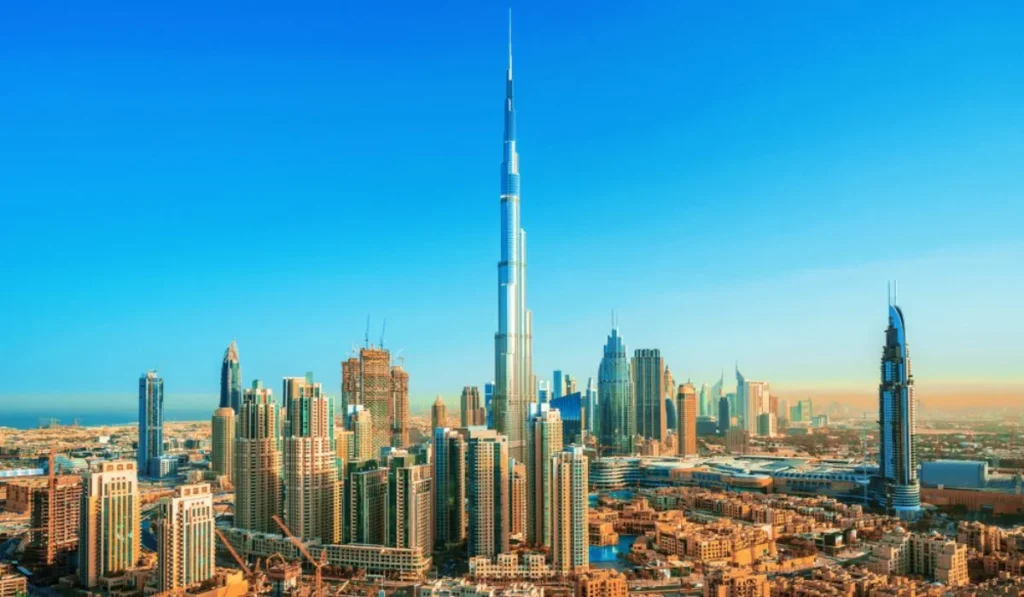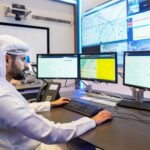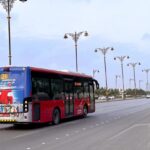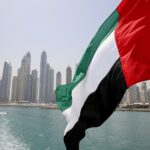The United Arab Emirates (UAE) is a captivating and dynamic country located at the Middle East and Asia crossroads. Nestled along the southeastern coast of the Arabian Peninsula, the UAE is a federation of seven emirates, each with unique charm and distinct characteristics. These emirates include Abu Dhabi, Dubai, Sharjah, Ajman, Umm Al-Quwain, Ras Al Khaimah, and Fujairah. Together, they form a nation that seamlessly blends tradition and modernity, making it a fascinating destination for tourists and business enthusiasts.
Table of contents:
- Land of the UAE
- People
- Economy
- Government and society
- Culture life
- History
Land of the United Arab Emirates
Portugal’s area is somewhat more extensive than the United Arab Emirates. Oman and Saudi Arabia border it on the east and northeast, west and south, respectively. The exact location of the country’s borders is still up for debate. The legal basis of a secret 1974 deal between Saudi Arabia and the United Arab Emirates, which is supposed to have settled their three boundary disputes, is unclear. The United Arab Emirates asserts ownership of a section of coastline that, according to Saudi Arabia, was given to it as part of the 1974 deal and that borders Qatar to the northwest. It also contests Saudi claims to the Shaybah oil field to the south, and Saudi Arabia (as well as Oman) have occasionally disputed the claims of the emirates to an oasis near the city of Al-Ain. Additionally, since the early 1990s, the emirates and Iran have been at odds to control three islands: Ab Ms, Greater and Lesser Tunb (UNB al-Kubr and UNB al-ugh), and Tunb.
Relief
Most of the country is made up of desert with massive dunes. East of Ardah, in the oases of Liwa, are some of the most extensive dunes in the world. Al-Ain, 100 miles (160 km) east of Abu Dhabi, is home to a significant oasis. The only other considerable relief feature may be found along the Musandam Peninsula’s eastern side in the Ajar Mountains’ northern extension, which are also shared with Oman. Elevations in this area reach roughly 6,500 feet (2,000 meters). Small boats can find cover on the islands and shoals that dot the Persian Gulf coast. Although there are no naturally occurring Deepwater harbours, significant ports in Abu Dhabi, Sharjah, and Ras al-Khaimah, as well as Port Rashid in Dubai and the enormous Port Jebel Ali, both of which are located 20 miles (32 km) southwest of Dubai City, are all artificial. Dibba, Khor Fakkan, and Kalba are three natural harbours on the more regular Gulf of Oman coast.
Drainage
No perennial streams or recurrent surface water sources exist in the United Arab Emirates. The country’s continually shifting dunes regularly obstruct the drainage of the country’s interior salt flats, or sabkhahs, where the little precipitation that does fall is drained from the mountains in the form of seasonal wadis. The Ma Salt Flat extends southward into Saudi Arabia in the far west, and coastal sabkhahs, which periodically experience flooding from the seas of the Persian Gulf, are found near Abu Dhabi.
Climate
The weather is hot and muggy along the seaside, whereas inland, the weather is even hotter but drier. Although it varies significantly from year to year, rainfall only averages 4 to 6 inches (100 to 150 mm) per year. The average temperature in January is 64 °F (18 °C), while the average temperature in July is 91 °F (33 °C). On the shore, summertime highs can reach 115°F (46°C), whereas in the desert, they can reach 120°F (49°C) or more. The Shamal (Arabic for “norther”) winds, which blow from the north and northwest in midwinter and early summer, carry sand and dust.
Plant and Animal life
Due to the dry climate, Abu Dhabi’s vegetation is sparse and primarily comprised of low shrubs that provide foraging for nomadic herds. However, millions of trees, particularly mangroves, have been planted there, creating habitat for various species. Date palms and Lucerne (Lucerne) are grown together in the oases. Fruits are farmed, and the mangoes from the Al-Ayn oasis to the east of Abu Dhabi are famous. Domesticated goats, sheep, and camels are among the animal life, along with cattle and poultry that were more recently imported. Predators like the caracal, sand cat, Ruppel’s (Vulpes rappelling), and red foxes, as well as larger animals like the Arabian oryx and Arabian and Persian gazelles, smaller mammals like the cape hare, lesser jerboa, and various types of gerbils, as well as a wide range of snakes and lizards, make up wildlife. Schools of mackerel, grouper, tuna, and porgies, as well as sharks and even whales, can be found in the waters of the Gulf. The government launched a conservation and management programme in the 1990s to safeguard and maintain the desert’s animal and plant life.
People
Ethnic group
The proportion of citizens in the Emirates is just about one-ninth. Most of the remaining people depend on foreign workers, with South Asians making up most of these groups. Another sizable part comprises Arabs from nations other than the United Arab Emirates and Iranians. An increasing number of Southeast Asians, especially Filipinos, have migrated to work in diverse occupations.
Languages and Religion
Arabic is the United Arab Emirates’ official language. Most native Emiratis speak a dialect of Gulf Arabic that is typically comparable to that spoken in neighbouring nations, and Modern Standard Arabic is taught in schools. The expatriate population speaks many languages, including diverse Pashto, Hindi, Balochi, and Persian dialects. Additionally, English is extensively used.
Muslims comprise about three-fifths of the population, roughly four-fifths of them being Sunnis; Shi’i minorities can be found in Dubai and Sharjah. Hindus and Christians are also minorities in the nation, though their numbers are rising.
Settlement patterns and demographic trends
Although Al-Ain, an oasis hamlet in the interior of the country, has developed into a significant population centre as well, the United Arab Emirates population is predominantly concentrated in cities along both of its beaches. There are exclaves in several emirates.
The federation’s infant mortality rate has significantly fallen, and its birth rate is one of the lowest among the Persian Gulf republics. More than two-thirds of the population is male, and almost three-fourths of the population is under 45 due to the significant number of foreign employees. The country has a far lower death rate than the global norm, and people here live roughly 79 years on average. Cardiovascular disease, poisoning and accidents, and cancer are the leading killers.
Economy
The petroleum industry, based predominantly in the emirate of Abu Dhabi, drives the federation’s economy. Abu Dhabi, the richest of the emirates, is a significant contributor to the national budget and has one of the highest concentrations of proven oil reserves in the world. The emirate of Dubai, whose economy is based more on commerce than on oil, is a regional commercial and financial powerhouse and the nation’s economic leader in terms of diversification.
Agriculture and Fishing
The usage of wells and pumps to provide water for irrigation has increased significantly, with most of the growth occurring in the emirates of Ras al-Khaimah and Fujairah, the two Ajman provinces, and Al-Ain. Although it employs less than ten per cent of the workforce, agriculture only makes up a minor portion of the GDP. The United Arab Emirates produces many dates, tomatoes, cucumbers, and eggplants and is almost self-sufficient in these crops. The nation also has enough dairy, eggs, fish, and poultry to cover its needs, but it must import the majority of other staples, including cereals. The Al-Ain-based Arid Lands Research Centre researches cultivating crops in arid environments. Umm al-Quwain is the location of most commercial fishing, and the emirates have one of the largest fishing industries in the Arab world.
Resources and Power
Abu Dhabi’s government, through the Abu Dhabi National Oil Company (ADNOC), has a majority stake in every oil-producing company in the federation since the discovery of oil there in 1958. Even though the oil and gas industry only employs a small portion of the workforce, it is responsible for roughly 95% of the nation’s oil output, and petroleum and natural gas production contributes to around one-third of the country’s GDP. ADNOC subsidiary Abu Dhabi Marine Operating Company (ADMA-OPCO), partially owned by British, French, and Japanese interests, has the most significant petroleum concessions. In Umm al-Shaf, one of the prominent offshore fields is situated. The al-Bunduq offshore field is operated by ADMA-OPCO and is shared with adjacent Qatar. At Al-Mubarraz, an offshore rig is run by a Japanese consortium, and American businesses are the owners of additional offshore concessions. Another ADNOC entity, the Abu Dhabi entity for Onshore Oil Operations, which is also partially owned by American, French, Japanese, and British interests, is in charge of holding onshore oil concessions. Japanese corporations also have other privileges.
Dubai started producing oil in 1969. Offshore oil fields can be found in Haql Fath, Fallah, and Rashid. Long maintaining a controlling stake in its oil reserves, the emirate fully assumed control of oil production in 2007. At its height, Dubai contributed almost one-sixth of the nation’s total petroleum output. However, when the emirate diversified its economy, production decreased to a minimal level. In 1974, Sharjah started producing oil; six years later, a second well was found that mainly made natural gas. In the Persian Gulf, oil production began in 1984 off the coast of Ras al-Khaimah.
Most of the federation’s natural gas resources are in Abu Dhabi, which has some of the world’s most significant natural gas reserves. The United Arab Emirates started making substantial investments in the late 1990s to grow its natural gas industry, both for export and to fuel domestic thermal power plants.
The United Arab Emirates has one of the world’s highest per capita energy consumption rates because it relies on energy-intensive technology like air conditioning and water desalination and because fuel subsidies have encouraged unnecessary energy use. Despite having substantial hydrocarbon reserves, the emirates were compelled to import natural gas and use petroleum reserves at a fraction of the export price in the first ten years of the twenty-first century due to a sharply rising internal demand caused by population expansion and industrialization.
The federation started looking at other domestic energy sources to protect future hydrocarbon output. The emirates hired the Korean Electric Power Company in 2009 to construct four nuclear reactors in the nation by 2020. Dubai and Abu Dhabi have also started to invest in renewable energy. A 100-megawatt facility in Abu Dhabi that could power up to 20,000 houses was one of the largest solar power plants in the world when it was first installed in 2013.
Manufacturing
Manufacturing has played a crucial role in the Emirates’ efforts to diversify its economy from total reliance on oil. A petroleum refinery, a gas fractionation facility, and an ammonia and urea plant are all part of a petrochemical industrial complex developed at Al-Ruways, 140 miles (225 km) southwest of Abu Dhabi city. The money generated by Dubai has gone towards projects like a trade centre and a dry dock. A second airport was built close to the Jebel Ali port, and more hotels have been constructed, including the eye-catching Burj al-Arab (“Tower of the Arabs”), which opened in the late 1990s. When it opened in 2010, the Burj Khalifa (also known as the “Khalifa Tower”) skyscraper in Dubai became the tallest building and the highest freestanding structure in the world. Cement plants, plastic pipe manufacturers, and paint factories have all been constructed in Sharjah. Less than a tenth of the nation’s GDP comprises manufacturing.
Finance of the United Arab Emirates
In 1980, Dubai and Abu Dhabi each contributed half of their annual revenues to the establishment that would become the Central Bank of the United Arab Emirates. Additionally, the bank issuing the national money of the emirates, the UAE dirham. The financial institutions include commercial, investment, development, foreign, domestic, and bankers’ associations. After fraudulent practices at Abu Dhabi’s Bank of Credit and Commerce International (BCCI), which was partially owned by the ruling family, were exposed in 1991, the bank’s global activities were shut down. As a result, the emirate established the Abu Dhabi Free Zone Authority to establish a new financial hub. The Dubai Financial Market (Suq Dubayy al-Mali; DFM), the first authorized stock exchange for the emirates, debuted in 2000. The Dubai International Financial Exchange debuted in 2005.
The development of contemporary Islamic finance—financial practices that adhere to Shariah norms of transaction—has been spearheaded by the United Arab Emirates. The first commercial Islamic bank in the world was established in 1975 as Dubai Islamic Bank (DIB). In 1985, the government started passing laws governing Islamic finance as more Islamic banks emerged and Islamic finance gained prominence. The DFM became the first stock exchange to adhere to Islamic financial norms in 2007. Islamic financial institutions in the United Arab Emirates have grown to be a particularly alluring market for Islamic organizations worldwide due to the country’s status as an international financial and commercial centre.
In the meantime, money laundering, terrorism financing, and other illegal financial activity have made financial institutions in the United Arab Emirates an appealing target due to their geographic location, high volume of international trade, and lax business and finance regulations. This issue is thought to be made worse by unofficial financial networks and practices (referred to as “hawala” in the Arab world), which have their roots in Silk Road trade networks that predate modern financial regulation. As a result, the nation has made substantial attempts to strengthen laws, curb illicit economic activities, and push ‘hawala’ networks’ into the formal market in the twenty-first century.
Trade
Dubai and Sharjah have traditionally valued trade. Dubai’s prosperity was ensured even before the oil was discovered by its position as the principal entrepôt in the Persian Gulf. (It was famous for being a way to smuggle gold into India.) To promote trade, the United Arab Emirates joined the World Trade Organization in 1995 and has since created a variety of free-trade zones, technology parks, and cutting-edge ports. The 1980s saw the development of Port Jebel Ali, a sizable free-trade zone that has done much to draw in foreign manufacturing companies interested in creating goods for export.
Petroleum and natural gas account for the majority of exports. The principal imports are gold, precious stones, food, and industrial and transportation equipment. China, India, Japan, and Western European nations are important trading partners. Reexports to nearby Gulf nations make up a significant portion of the trade.
Services
Since the late 1990s, the service sector—which includes public administration, defence, tourism, and construction—has become increasingly important to the economy, mainly as the nation has worked to draw in tourists and foreign investors. The government has promoted significant infrastructure projects, particularly the construction of lodging and transit systems—hotels, resorts, restaurants, and airport expansion—to enhance its tourism and commercial sectors.
Labour and Taxation
Around 90% of the Labour force comprises expatriates, with some private sector locations having a higher percentage. These workers frequently worked in unfavourable conditions, and at the start of the twenty-first century, the state forbade unionization. The emirates, which rely primarily on foreign Labour, have tried to reduce the number of foreign workers through a programme called “Emiratization,” which offers financial incentives to companies that hire Emirati citizens.
Early in the twenty-first century, the issue of foreign Labour remained despite significant advancements. The use of kids (often from abroad) as jockeys in camel races is now prohibited by new legislation that forbids work during the sweltering summer daytime hours. Additionally, several unpaid strike actions and demonstrations by foreign workers against a significant construction and development firm in 2005 ended in the workers’ favour. Early in 2006, the government announced it was preparing a new law allowing for the creation of unions and wage negotiation; nevertheless, later that year, it approved a bill allowing for the deportation of workers who were on strike, and worker organization remained unlawful. Over the years, the government gradually increased worker protections and rights. Still, it wasn’t until 2017 that the United Arab Emirates Labour laws achieved the minimal requirements of the International Labour Organization.
In the United Arab Emirates, there is no income tax, only international banks and oil firms are subject to corporate taxes. The sale of petroleum products accounts for the majority of non-tax income that the government receives. Still, consumption taxes have recently started to supplement that income. 2017 saw the implementation of an excise tax on cigarette goods, energy drinks, and carbonated beverages. The United Arab Emirates imposed a value-added tax for most products and services in 2018 in coordination with other Gulf nations.
Transportation and telecommunications
The country has a first-rate road network that was built in the late 1960s and early 1970s and connects it to its neighbours. The little saltwater strait that separates Dubai City from the nearby economic hub of Dayrah is made more accessible to cross thanks to the building of a tunnel to the bridges that connect the two. International airports serve Abu Dhabi, Dubai, Sharjah, Ras al-Khaimah, Fujairah, and Al-Ain. 2010 saw the opening of a second airport to service Dubai. One of the busiest airports in the Middle East is the older one in Dubai. The federation is home to several sizable, contemporary seaports, such as those at Port Rashid in Dubai, which is served by a sizable shipyard, and Port Jebel Ali, which is located in one of the busiest gulf ports and one of the world’s largest artificial harbours. Sharjah has a minor port north of the city, one of the most minor harbours on the Gulf of Oman. The first metro system in the Gulf started operating in Dubai in September 2009 with the opening of the first section of a remote-controlled rapid-transit line. There are also plans for other public transport initiatives, such as an Abu Dhabi monorail system and connections to the Saudi rail networks. The first phase of the railway connecting all seven emirates, from Abu Dhabi to Dubai, was finished in 2022. A Hyperloop system will also connect Abu Dhabi and Dubai.
The state-owned Emirates Telecommunications Corporation, also known as Etisalat (Ittiṣālāt), is a significant telecommunications provider in the nation. There is widespread and widespread use of radio, television, telephone, and cellular telephone service. When Etisalat started offering Internet access in 2000, the Emirates quickly surpassed other Middle Eastern nations regarding the number of subscribers per capita. Emirates Integrated Telecommunications Company (du), a second licensed provider, started offering phone and high-speed Internet service in 2005. In 2006, they arranged with Etisalat to link their networks.
Government and society
Constitutional framework
The Federal Supreme Council, comprised of the nearly hereditary rulers of the seven emirates, is the highest governing body. The Supreme Council selects its members to serve as the federation’s president and vice president for five years each. The president chooses a cabinet and prime minister. The Federal National Council, a unicameral legislature, is an advisory body of 40 members selected by the several emirates for two-year terms. A temporary constitution was approved in 1971 and was made permanent by the Supreme Council in 1996.
Local government
In the United Arab Emirates, the component emirates can exercise constitutionally reserved functions not explicitly delegated to the central government. A significant amount of power is exercised at the individual emirate level, particularly in Abu Dhabi and Dubai, and the distribution of power within the federal system is generally similar to that in other systems. For instance, the federation government administers foreign policy, determines broad economic policy, and oversees the social welfare system.
Justice
The constitution mandates a Shariah-based legal code. The judiciary combines Western and Islamic legal concepts in practice. The Union Supreme Court and several courts of first instance make up the federal judiciary; the former handles conflicts between emirates and crimes against the state, while the latter handles administrative, commercial, and civil disputes between private parties and the federal government. Local judicial organizations are in charge of other legal issues.
Political process
The most politically significant tribe in each emirate (an agnatic lineage group of several related families) generally holds the leadership position in that emirate. The emir is chosen from among their number by the notables of the ruling tribe; he is typically, but not always, a son of the previous emir. However, each tribe has its sheikh or leader, and maintaining the position of the ruling dynasty requires a certain amount of political plurality. The majlis, or council meeting, is a structure that greatly facilitates this. Anyone subject to the leader’s control should theoretically be allowed access to the majlis because the leader hears complaints, resolves conflicts, and distributes largesse.
In the emirates, there are no political parties, and no elections were held before the turn of the century. Every four years, an electoral college convenes to choose half of the Federal National Council’s membership; the other half is selected by appointment. At least half of the council members must be women starting with the 2019 elections. Less than 7,000 people made up the Electoral College when the first election was held in 2006; by the third election in 2015, more than 224,000 people, or about one-third of the voting-age population, were represented; by 2019, the number had increased to 337,000 and for the first time, slightly more women than men were represented.
Security
The defence forces of the emirates were combined in 1976. However, the ones in Dubai and Abu Dhabi have kept some of their independence. The Supreme Council granted the national government the authority to assemble an armed force. The Supreme National Security Council was established in 2006 to address the emirates’ security requirements. This council comprised the president, prime minister, and chief of staff of the armed forces. The total military budget and the military budget per capita are significant for a nation the size of the Emirates. Despite having a small navy and air force and many foreign service members, the army employs most of its people.
Health and welfare
Medical services are focused on Dubai and Abu Dhabi, which have many hospitals, child welfare clinics, and other health facilities, and hospital treatments are accessible to nationals. The emirates started privatizing health care in the late 1990s, significantly increasing the number of hospitals and doctors. Because the government pays for its citizens’ health insurance, public spending on health care has increased simultaneously as privatisation.
Housing
Construction and financing of housing, and the development of civil infrastructure, including power, water, and trash removal, account for a sizeable amount of government spending, both at the federal and local levels. The federation government makes housing available to its inhabitants through direct low-interest loans, subsidies for rental properties, and accessible housing grants. Thousands of Emiratis have benefited from these programmes.
Education
All children between 6 and 18 must attend free, public primary and secondary schools in the Emirates. Both boys and girls participate in public schools, and there are several excellent universities in the Emirates. At the United Arab Emirates University, which began in Al-Ain in 1977, as well as the Higher Colleges of Technology system established throughout the emirates in 1988, female students outweigh male students by a significant margin. Zayed University was founded in 1998 to offer technical education to women, but in 2008, it started accepting applications from males as well. Overall, women make up over 70% of Emirati university graduates, even thomen beingntly more likely than women to pursue further education abroad. The vast majority of people were literate by the 2010s.
Cultural life
The United Arab Emirates’ cultural practices are in Islam and are popular throughout the Arab world, particularly in the Persian Gulf neighbours. The Islamic revival has impacted the federation, even though Islam is generally practised less strictly in the emirates than in Saudi Arabia. Despite urbanization and the existence of a sizable expat community, tribal identities in the United Arab Emirates are still quite strong, and the family is still seen as the most robust and most cohesive social unit.
Daily life and social customs
The cultural life of the federation has changed in numerous ways. The region is changing its views on marriage and women’s employment. The constitution contains a variety of safeguards and protections for women, and the government actively participates in women’s empowerment. Women in the Emirati workforce make up a little under half of the total population.
Few Emiratis still lead nomadic lifestyles or cruise the Persian Gulf in search of fish and pearls, but many traditional ways of life are being practised today. Most Muslims observe the major Islamic holidays, including the Eid (festivals), Eid al-Fitr and Eid al-Adha, and traditional attire is still the standard. Traditional clothing for women consists of a light chemise called a dir, frequently layered with a more elaborate dress (thawb). A loose pair of trousers called a serial is worn underneath the garment. Women are still expected to cover their heads with a shawl, which can also be worn as a veil (hijab or burqa) when they are outside the home or in the presence of outsiders. Emirati women typically dress in various delicate, bright, and intricately embroidered fabrics, as well as excellent gold and silver jewellery.
A long, plain, ankle-length garment known as a kandurah or dishdashah (or possibly thawb) is the standard attire for men. The garment, often composed of white cotton, can also be made of heavier fabric and come in different colours. The traditional head covering is the ghutrah, also known as a kaffiyeh and typically white or white-and-red checkered. It is secured in place by a black cord made of camel hair called an iqal. The material, colour, and style of headgear may differ depending on the group.
The diverse cultural influences that the nation has encountered over the years are reflected in Emirati cuisine. Arab cuisine staples include hummus, falafel, ful (spiced bean paste), and shawarma (broiled meat served on flatbread). In contrast, the Emirati preference for rice as a staple and the use of saffron, cardamom, and rose water as flavouring in desserts show the influence of Iranian cuisine. One of the most popular dishes is makbus, which consists of meat, chicken, or fish over rice seasoned with herbs and dried lime. Such in every other country in the region, lamb and chicken are the most popular meat options. Fresh fruits, such as as dates, figs, lemons, limes, veggies, and flatbread (khubz), are staples. The most popular beverage is coffee, served hot, robust, and sweet.







